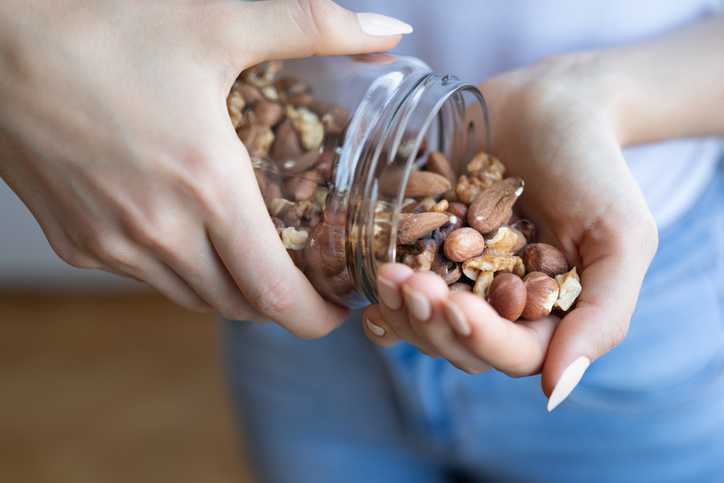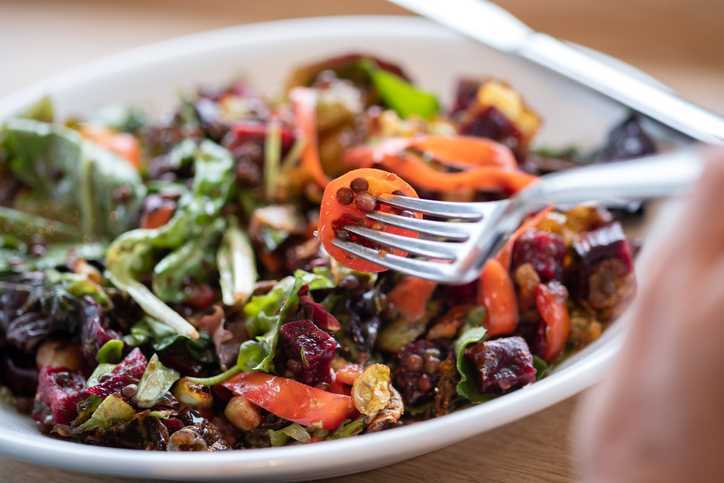- Dietary fibres are carbohydrates that our bodies cannot digest.
- Once they reach the large intestine, fibres may be broken down by the gut microbiome (the resident gut bacteria and their genes), providing fuel for their growth and activity.
- Some fibres can provide bulk to our stool and help keep us regular.
- You can find fibres in whole grain cereals, fruit, vegetables, legumes, nuts and seeds. You can also take fibre supplements.
- There are many types of fibre, each with unique properties that influence how they behave in the gut.
- Eating a range of fibres from different sources will lead to a more diverse gut microbiome. This is thought to be most beneficial for health.
4 minute read
What is fibre?
Fibres are carbohydrates that are unable to be digested in the small intestine. As a result, fibres pass into the large intestine (or colon) where they can be broken down by the gut microbiota (bacteria and other organisms).
This process provides fuel for the microbiota and generates by-products (such as short chain fatty acids) that help the gut and other body systems.
Fibres can come from dietary sources or can be increased in the diet through supplements. Following a diet rich in fibre-containing foods has many health benefits, from enhancing satiety (feeling full) to reducing the risk of:
- constipation
- diverticular disease
- bowel and breast cancer
- cardiovascular disease
- type 2 diabetes.
Fibre supplements can also improve specific aspects of gut function, such as stool consistency and regularity.
Different types of fibre
There are many different types of fibre. These include:
- cellulose and lignins (found in plant cell walls)
- β-glucans (found in oats and barley)
- inulin (found in certain cereals, fruit and vegetables).
Historically, all fibres have been categorised based on solubility, although recent research suggests there are other important attributes of fibres that influence how they function in the gut.
However, current guidelines for people with gastrointestinal disorders (for example, irritable bowel syndrome, constipation) and other conditions (for example, high cholesterol) still refer to fibres as either insoluble or soluble.
Insoluble fibres remain intact when dispersed in water. They are thought to add bulk to the contents of the gastrointestinal tract and help keep our bowel movements regular. These fibres are typically found in the hard, scratchy outer skins and surfaces of roots, grains and seeds.
Foods higher in insoluble fibres include:
- whole grain breads and cereals
- fruit and vegetables (including the skins)
- nuts and seeds.

Soluble fibres dissolve in water. Some types of soluble fibre can form a thick gel in your stomach and help to slow down the passage of food through your gastrointestinal tract. These soluble fibres can improve blood glucose levels in people with type 2 diabetes. They can also reduce LDL (unhealthy) cholesterol by collecting fatty deposits as it moves through the intestine.
Foods higher in soluble fibres include:
- oats and barley
- fruit and vegetables
- beans and lentils.

Certain types of fibre can also be described as ‘prebiotic’. These fibres, once they reach the large intestine, are selectively degraded by gut microbiota. This delivers certain health benefits.
Prebiotic fibres typically exist as supplements, but food sources also exist. These include:
- fructans and inulin (certain cereals, fruits and vegetables)
- galacto-oligosaccharides (certain cereals, beans and lentils)
- resistant starch (underripe bananas, cooked and cooled potato).
Choosing foods in quantities as recommended in the Australian Dietary Guidelines will provide sufficient fibre, including prebiotic fibres, to provide health benefits. An Accredited Practising Dietitian (APD) can advise on how to meet healthy eating guidelines.
Fibre and gut health
Gut health is a modern concept that has come to be synonymous with overall health and wellbeing. But what does it mean? There is no clear-cut definition, and the term is rarely used in the scientific literature.
Generally, it is used to describe the absence of gut symptoms (for example, abdominal pain or diarrhoea) and gastrointestinal disease (such as colon cancer). It is also thought the gut microbiome (collection of bacteria and their genes) is central to achieving good gut health.
Fibre is a central part of the diet that is degraded by the gut microbiome. It is thought to be a key player in achieving ‘gut health’. Eating a variety of types of dietary fibre is likely to achieve a more diverse microbiome, which is thought to be most beneficial for overall health.
Meeting your daily fibre needs
Australians are recommended to eat at least 25-30g of fibre each day. Below is an example of how an adult can meet their daily dietary fibre requirements (fibre-rich foods in green).
|
Meal |
Food | Fibre content |
|---|---|---|
| Breakfast |
Whole grain cereal (¾ cup) Milk, any variety (1 cup) Hard-boiled egg (1 large) |
4.5g |
| Snack |
Apple, with skin (1 medium) Almonds (handful) |
7g |
| Lunch |
Wholemeal bread (2 slices) Mixed vegetables (½ cup) Roast beef (30 g) |
6g |
| Snack |
Orange (1 medium) Yoghurt, any variety (½ cup) |
2.5g |
| Dinner |
Mixed vegetables (½ cup) Carrot (¼ cup) Corn (¼ cup) Peas (¼ cup) Tofu, firm, fried (170 g) |
8g |
| Supper | Hot chocolate | 0g |
| Total | 28g |

We recommend seeing an Accredited Practising Dietitian (APD) if you:
- have gut symptoms that are bothering you (bloating, abdominal pain)
- have difficulty passing stool (straining or just not satisfied with your bowel movements)
- would like to increase your fibre intake but need help to achieve your goals
- have a condition mentioned on this page and would like advice on how to change your diet.
APDs are university-trained nutrition experts. They can help you with personalised, easy-to-follow evidence-based advice.
APDs are Australia's most trusted dietetics professionals.
- When increasing your fibre intake, do it slowly. Your gastrointestinal tract needs to adapt to the changes in stool bulk and the increases in bacterial breakdown (fermentation) and resulting gas production in the large intestine. Try adding in small quantities of a new high fibre food every few days and spread your fibre out throughout the day.
- Some easy ways to add fibre:
- add a teaspoon of linseed or LSA (linseed, sunflower, almond mix) to your breakfast cereal
- choose wholemeal (whole grain) breads, rice and pasta over white varieties
- include fruit, vegetables, nuts or seeds at snacks
- add legumes to dinner (for example, lentils in spaghetti bolognese, chickpeas in a salad).
- More is not always better! Some people who are sensitive to gas production from bacterial fermentation may benefit from reducing certain types of fibre.